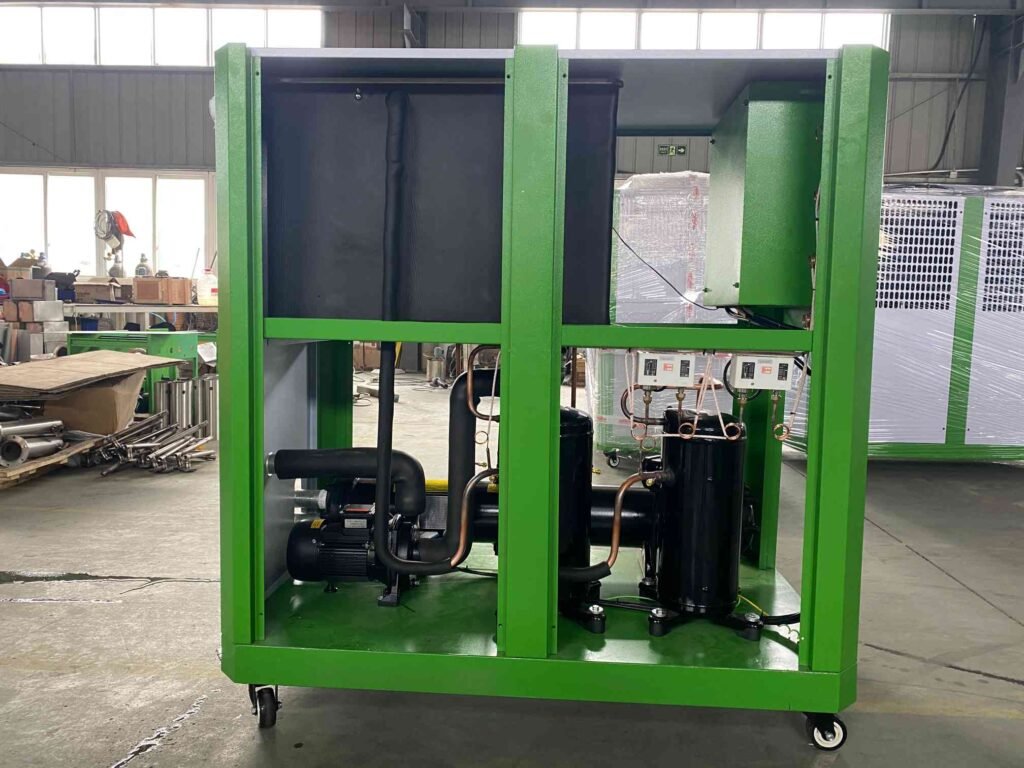Maintaining industrial chillers involves performing a series of routine tasks to ensure these machines operate efficiently. Proper maintenance of industrial chillers typically prevents breakdowns and extends their service life. Studies indicate that regular maintenance can save 11.1% in annual energy costs, reduce monthly energy consumption by 8,380 kWh, and lower repair expenses by 40%. This article examines the significance of industrial chiller maintenance, outlines essential component upkeep tasks, and offers practical maintenance tips to help ensure your chillers operate reliably in the long term.
Ⅰ. The Importance of Industrial Chiller Maintenance
1. Potential Issues Arising from Neglected Chillers
If you do not take care of industrial chillers, big problems can happen. Chillers that are not cared for often need expensive repairs. Broken parts may need to be replaced, which costs a lot. When chillers do not function properly, they consume more energy and incur higher operating costs. Sometimes, neglected chillers stop working completely. Owners then have to pay for emergency repairs or even new chillers. Bad maintenance can also cause more greenhouse gases and leaks that hurt the environment.
2. The Role of Maintenance
Routine maintenance is essential for chillers. It helps them last longer by stopping damage, keeping the system from rusting, and helping it work right. When technicians check chillers often, they can find small problems early, which means less downtime and better work.
Keeping daily logs is very important for watching how chillers work. Technicians use these logs to see patterns and find problems early. The logs show how the chiller has worked over time. This helps with fixing and preventing problems. Writing down temperatures, pressures, and what work was done helps staff see problems before they get worse.
- Daily logs should include:
- Operating temperatures
- System pressures
- Water flow rates
- Refrigerant levels
- Maintenance actions performed
Chillers that get regular care work better and last longer. Cleaning condenser coils and fixing refrigeration parts can help save energy. Owners who take care of chillers save money and avoid sudden breakdowns.
Ⅱ. Key Components and Maintenance Tasks
1. Preventive Maintenance for Industrial Chillers
Preventive maintenance helps chillers work better and last longer. Regular checks and cleaning keep everything running well. Technicians look for leaks and check fluid levels. They also inspect all the parts. Daily logs of temperatures, pressures, and water flow are important. These logs help find problems early and stop bigger issues. Cleaning coils, tubes, and filters is needed. Lubricating moving parts and changing worn parts helps too. Preventive maintenance cuts downtime and saves money by stopping big repairs.

2. Evaporator and Condenser Coils
Evaporator and condenser coils move heat in the chiller. Dust and dirt on these coils can lower how well they work by up to 21%. Dirty coils make the chiller use more energy and wear out other parts faster. Cleaning these coils once a year is best. Sometimes, cleaning twice a year, before summer and winter, keeps the system working great.
3. Refrigerant Level
Having the right refrigerant level is very important for chillers. Low refrigerant can make cooling worse and stress the system. This can raise energy bills and shorten the chiller’s life. Technicians should check refrigerant levels often and look for leaks. Fixing leaks early keeps the chiller working well and stops damage.
4. Compressor
The compressor is a very important part of chillers. Problems can show as loud noises, leaks, or sudden jumps in energy use. Regular checks, cleaning, and oiling keep the compressor working well. Technicians should test safety controls and change bad parts quickly. These steps help stop breakdowns and make the chiller last longer.
5. Water Flow and Water Quality
Good water flow and clean water help chillers work well. Scale, rust, or germs can block pipes and lower how well the chiller works. Checking water flow and cleaning tubes helps stop these problems. Using water treatment stops scale and keeps things running smoothly. Regular checks and cleaning protect the chiller and lower repair costs.
Ⅲ. Practical Maintenance Tips
1. Develop a maintenance plan
A good industrial chiller maintenance plan helps chillers work well. Teams should check chillers often. They need to look at refrigerant levels and change old parts early. Each place needs its own plan because needs are different. Staff should watch logs and check important numbers often. Water treatment and chemical tests help protect the system. Cleaning coils and checking heat transfer keep things working.
2. Train the team
Trained staff can find problems early and fix them fast. Training has practice and classroom lessons. Some training happens twice a year and teaches basic and hard skills. Teachers with real experience lead these lessons. Teams learn how to use, care for, and fix chillers safely.
3. Leverage technology
New technology helps watch chillers better. Health tools, sensors, and cameras find problems early. Vibration sensors and pressure tools show data right away. Special software helps chillers last longer, cost less, and work better. These tools also save energy and help the environment.
4. Partner with a reliable industrial chiller supplier
A trusted supplier helps with long-term care. They give special maintenance plans and help quickly in emergencies. Good suppliers talk clearly and give steady help. They help places keep chillers working all year and stop downtime.
Ⅳ. Conclusion
Doing regular maintenance on industrial chillers has many good results. It helps the chiller work well and stops it from breaking down. It also uses less energy and saves money. Taking care of the chiller makes it last longer. If you take care of chillers early, you can save a lot of money every year. You also do not have to buy new chillers as soon.
